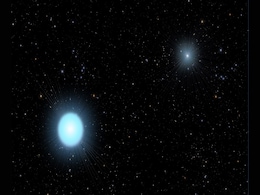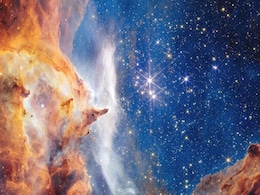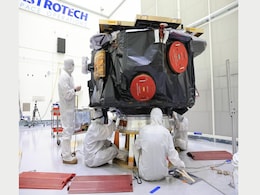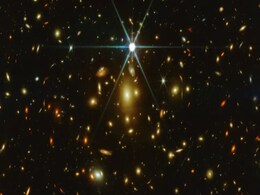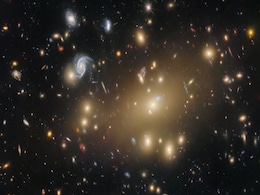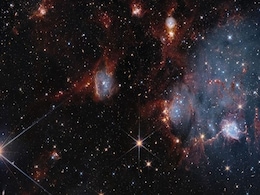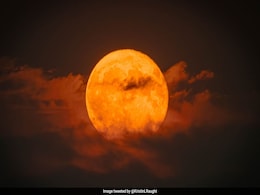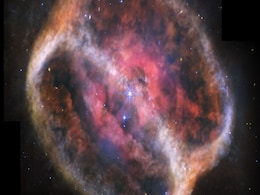Star Cluster
- All
- News
- Videos
-

Astronomers Uncover the Vast Greater Pleiades Complex with 3,000 Hidden Stars
- Monday November 17, 2025
Astronomers analyzing Gaia and TESS data have discovered that the famed Pleiades is only the bright center of a much larger stellar complex containing over 3,000 stars. Spanning 2,000 light-years, this vast family reveals how young clusters form, travel, and disperse across the galaxy.
-
 www.gadgets360.com
www.gadgets360.com
-

James Webb Telescope May Have Spotted First Generation of Stars in the Universe
- Sunday November 16, 2025
Astronomers using JWST may have discovered Population III stars in cluster LAP1-B, offering new insights into early galaxy formation and the universe’s first luminous objects. JWST observations suggest Population III stars may have formed 13 billion years ago, helping trace early galaxies. These stars might be building blocks for larger galaxies ...
-
 www.gadgets360.com
www.gadgets360.com
-

NASA Hubble Space Telescope Uncovers One of the Youngest Known Blue Straggler–White Dwarf Systems
- Thursday September 11, 2025
Italian astronomers using the Hubble Space Telescope have discovered a white dwarf orbiting a blue straggler star in the globular cluster 47 Tucanae, located 15,300 light-years away. The rare system, among the youngest detected, sheds light on stellar mass transfer and offers vital clues to the evolution of binary stars in dense clusters.
-
 www.gadgets360.com
www.gadgets360.com
-

NASA's James Webb Space Telescope Captures Lobster Nebula’s Towering Spires and Massive Stars
- Monday September 8, 2025
NASA’s Webb Telescope imaged the Lobster Nebula (NGC 6357), 5,500 light-years away. Its young star cluster, Pismis 24, contains giant stars carving glowing gas pillars. Pismis 24-1, once thought to be one supermassive star, is a triple system with stars up to 74 times the Sun’s mass.
-
 www.gadgets360.com
www.gadgets360.com
-

Ursa Major III May Be a Star Cluster, Not a Dark-Matter Dwarf Galaxy
- Sunday August 24, 2025
Astronomers have long thought Ursa Major III, also called UNIONS 1, was a dark-matter-packed dwarf galaxy. But new simulations suggest it may instead be a compact star cluster bound by black holes and neutron stars. Located 30,000 light-years away, Ursa Major III contains just ~60 visible stars yet shows puzzlingly high stellar velocities. The new ...
-
 www.gadgets360.com
www.gadgets360.com
-

Earendel: JWST Suggests the Most Distant Star May Be a Star Cluster
- Thursday August 21, 2025
Earendel, the farthest object ever seen, was first thought to be a single massive star from the early universe. New findings from JWST suggest it may instead be a star cluster, with many stars grouped together. Scientists used gravitational lensing to spot Earendel, which made its light appear thousands of times brighter.
-
 www.gadgets360.com
www.gadgets360.com
-

Hubble Uncovers Multi-Age Stars in Ancient Cluster, Reshaping Galaxy Origins
- Saturday July 19, 2025
A stunning new image from NASA’s Hubble Space Telescope reveals that ancient star cluster NGC 1786—located 160,000 light-years away in the Large Magellanic Cloud—hosts stars of varying ages. Once believed to contain a single generation of stars, NGC 1786 now appears to preserve a more complex stellar history. This multi-age discovery suggests...
-
 www.gadgets360.com
www.gadgets360.com
-

NASA’s Hubble and Webb Discover Bursting Star Formation in Small Magellanic Cloud
- Saturday July 12, 2025
NASA’s Hubble and Webb telescopes have captured spectacular images of NGC 460 and NGC 456, two star clusters in the Small Magellanic Cloud. These young, open clusters are filled with massive, hot stars that trigger new star formation by carving nebulae. The findings provide insights into early universe conditions and interstellar medium behaviour...
-
 www.gadgets360.com
www.gadgets360.com
-

Hubble Observations Give Forgotten Globular Cluster Its Moment to Shine
- Saturday July 5, 2025
NASA’s Hubble Space Telescope has unveiled ESO 591-12, a long-overlooked globular cluster glittering with multicolored stars. Captured during a survey of missing clusters, this image provides new insight into stellar evolution and the early Milky Way. It marks a vital step in resolving the structure and origin of ancient star systems hidden withi...
-
 www.gadgets360.com
www.gadgets360.com
-

Webb Telescope Spots Possible Jellyfish Galaxy 12 Billion Light-Years Away
- Thursday July 3, 2025
Astronomers using the James Webb Space Telescope have identified a possible jellyfish galaxy about 12 billion light-years away. Named COSMOS2020-635829, it shows tentacle-like streams of gas and stars trailing off one side—likely formed through ram pressure stripping in a dense cluster. If confirmed, it would be the most distant jellyfish galaxy ...
-
 www.gadgets360.com
www.gadgets360.com
-

NASA’s James Webb Space Telescope Reveals the Complex Structure of a Planetary Nebula
- Wednesday April 16, 2025
NASA's James Webb Space Telescope has unveiled the complex character of NGC 1514, a planetary nebula developing over at least 4,000 years. Only seen in infrared light, the nebula's rings now resemble "fuzzy" clusters set in twisted patterns. A network of sharper holes near the centre stars indicates where faster material punched through.
-
 www.gadgets360.com
www.gadgets360.com
-

Hubble Telescope Captures NGC 4536, a Starburst Galaxy with Intense Star Formation
- Wednesday March 26, 2025
NASA’s Hubble Space Telescope has captured a striking image of NGC 4536, a starburst galaxy 50 million light-years away in the Virgo constellation. The galaxy’s sweeping spiral arms are filled with young blue star clusters and ionized hydrogen gas, indicating rapid star formation. Astronomers believe its bar-like structure channels gas toward t...
-
 www.gadgets360.com
www.gadgets360.com
-

Mysterious Planetary-Mass Objects May Form in Young Star System Clashes
- Wednesday March 12, 2025
Recent research challenges traditional views on planetary-mass objects, suggesting they may form through violent interactions between young star systems rather than standard planetary or stellar processes. Simulations indicate these clashes create dense gas filaments that evolve into free-floating objects, often in binary pairs. This discovery expl...
-
 www.gadgets360.com
www.gadgets360.com
-

Hubble Captures Stunning Infrared Image of Sh2-284, a Massive Stellar Nursery
- Wednesday March 12, 2025
Hubble’s latest image of the massive Sh2-284 nebula reveals young stars concealed within thick clouds of gas and dust. Using infrared imaging, astronomers have captured details previously obscured in optical wavelengths. The nebula’s low-metallicity composition provides a glimpse into the conditions of the early universe, shedding light on how ...
-
 www.gadgets360.com
www.gadgets360.com
-

Astronomers Uncover the Vast Greater Pleiades Complex with 3,000 Hidden Stars
- Monday November 17, 2025
Astronomers analyzing Gaia and TESS data have discovered that the famed Pleiades is only the bright center of a much larger stellar complex containing over 3,000 stars. Spanning 2,000 light-years, this vast family reveals how young clusters form, travel, and disperse across the galaxy.
-
 www.gadgets360.com
www.gadgets360.com
-

James Webb Telescope May Have Spotted First Generation of Stars in the Universe
- Sunday November 16, 2025
Astronomers using JWST may have discovered Population III stars in cluster LAP1-B, offering new insights into early galaxy formation and the universe’s first luminous objects. JWST observations suggest Population III stars may have formed 13 billion years ago, helping trace early galaxies. These stars might be building blocks for larger galaxies ...
-
 www.gadgets360.com
www.gadgets360.com
-

NASA Hubble Space Telescope Uncovers One of the Youngest Known Blue Straggler–White Dwarf Systems
- Thursday September 11, 2025
Italian astronomers using the Hubble Space Telescope have discovered a white dwarf orbiting a blue straggler star in the globular cluster 47 Tucanae, located 15,300 light-years away. The rare system, among the youngest detected, sheds light on stellar mass transfer and offers vital clues to the evolution of binary stars in dense clusters.
-
 www.gadgets360.com
www.gadgets360.com
-

NASA's James Webb Space Telescope Captures Lobster Nebula’s Towering Spires and Massive Stars
- Monday September 8, 2025
NASA’s Webb Telescope imaged the Lobster Nebula (NGC 6357), 5,500 light-years away. Its young star cluster, Pismis 24, contains giant stars carving glowing gas pillars. Pismis 24-1, once thought to be one supermassive star, is a triple system with stars up to 74 times the Sun’s mass.
-
 www.gadgets360.com
www.gadgets360.com
-

Ursa Major III May Be a Star Cluster, Not a Dark-Matter Dwarf Galaxy
- Sunday August 24, 2025
Astronomers have long thought Ursa Major III, also called UNIONS 1, was a dark-matter-packed dwarf galaxy. But new simulations suggest it may instead be a compact star cluster bound by black holes and neutron stars. Located 30,000 light-years away, Ursa Major III contains just ~60 visible stars yet shows puzzlingly high stellar velocities. The new ...
-
 www.gadgets360.com
www.gadgets360.com
-

Earendel: JWST Suggests the Most Distant Star May Be a Star Cluster
- Thursday August 21, 2025
Earendel, the farthest object ever seen, was first thought to be a single massive star from the early universe. New findings from JWST suggest it may instead be a star cluster, with many stars grouped together. Scientists used gravitational lensing to spot Earendel, which made its light appear thousands of times brighter.
-
 www.gadgets360.com
www.gadgets360.com
-

Hubble Uncovers Multi-Age Stars in Ancient Cluster, Reshaping Galaxy Origins
- Saturday July 19, 2025
A stunning new image from NASA’s Hubble Space Telescope reveals that ancient star cluster NGC 1786—located 160,000 light-years away in the Large Magellanic Cloud—hosts stars of varying ages. Once believed to contain a single generation of stars, NGC 1786 now appears to preserve a more complex stellar history. This multi-age discovery suggests...
-
 www.gadgets360.com
www.gadgets360.com
-

NASA’s Hubble and Webb Discover Bursting Star Formation in Small Magellanic Cloud
- Saturday July 12, 2025
NASA’s Hubble and Webb telescopes have captured spectacular images of NGC 460 and NGC 456, two star clusters in the Small Magellanic Cloud. These young, open clusters are filled with massive, hot stars that trigger new star formation by carving nebulae. The findings provide insights into early universe conditions and interstellar medium behaviour...
-
 www.gadgets360.com
www.gadgets360.com
-

Hubble Observations Give Forgotten Globular Cluster Its Moment to Shine
- Saturday July 5, 2025
NASA’s Hubble Space Telescope has unveiled ESO 591-12, a long-overlooked globular cluster glittering with multicolored stars. Captured during a survey of missing clusters, this image provides new insight into stellar evolution and the early Milky Way. It marks a vital step in resolving the structure and origin of ancient star systems hidden withi...
-
 www.gadgets360.com
www.gadgets360.com
-

Webb Telescope Spots Possible Jellyfish Galaxy 12 Billion Light-Years Away
- Thursday July 3, 2025
Astronomers using the James Webb Space Telescope have identified a possible jellyfish galaxy about 12 billion light-years away. Named COSMOS2020-635829, it shows tentacle-like streams of gas and stars trailing off one side—likely formed through ram pressure stripping in a dense cluster. If confirmed, it would be the most distant jellyfish galaxy ...
-
 www.gadgets360.com
www.gadgets360.com
-

NASA’s James Webb Space Telescope Reveals the Complex Structure of a Planetary Nebula
- Wednesday April 16, 2025
NASA's James Webb Space Telescope has unveiled the complex character of NGC 1514, a planetary nebula developing over at least 4,000 years. Only seen in infrared light, the nebula's rings now resemble "fuzzy" clusters set in twisted patterns. A network of sharper holes near the centre stars indicates where faster material punched through.
-
 www.gadgets360.com
www.gadgets360.com
-

Hubble Telescope Captures NGC 4536, a Starburst Galaxy with Intense Star Formation
- Wednesday March 26, 2025
NASA’s Hubble Space Telescope has captured a striking image of NGC 4536, a starburst galaxy 50 million light-years away in the Virgo constellation. The galaxy’s sweeping spiral arms are filled with young blue star clusters and ionized hydrogen gas, indicating rapid star formation. Astronomers believe its bar-like structure channels gas toward t...
-
 www.gadgets360.com
www.gadgets360.com
-

Mysterious Planetary-Mass Objects May Form in Young Star System Clashes
- Wednesday March 12, 2025
Recent research challenges traditional views on planetary-mass objects, suggesting they may form through violent interactions between young star systems rather than standard planetary or stellar processes. Simulations indicate these clashes create dense gas filaments that evolve into free-floating objects, often in binary pairs. This discovery expl...
-
 www.gadgets360.com
www.gadgets360.com
-

Hubble Captures Stunning Infrared Image of Sh2-284, a Massive Stellar Nursery
- Wednesday March 12, 2025
Hubble’s latest image of the massive Sh2-284 nebula reveals young stars concealed within thick clouds of gas and dust. Using infrared imaging, astronomers have captured details previously obscured in optical wavelengths. The nebula’s low-metallicity composition provides a glimpse into the conditions of the early universe, shedding light on how ...
-
 www.gadgets360.com
www.gadgets360.com



